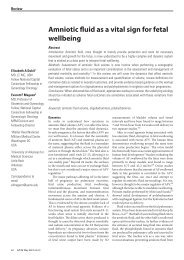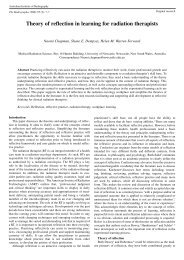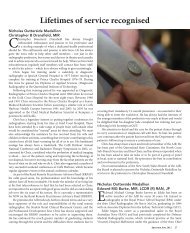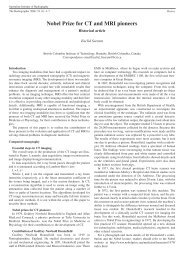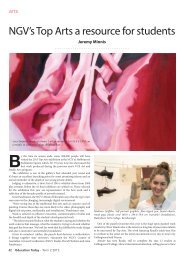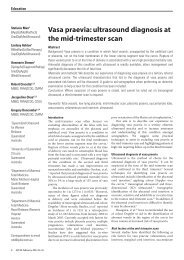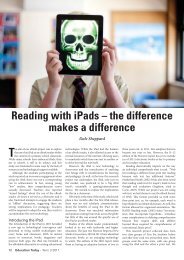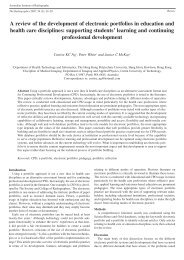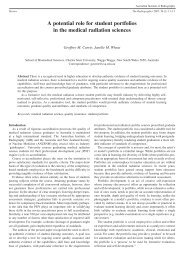Radiation Induced Diarrhoea – Literature Review - Minnis Journals
Radiation Induced Diarrhoea – Literature Review - Minnis Journals
Radiation Induced Diarrhoea – Literature Review - Minnis Journals
You also want an ePaper? Increase the reach of your titles
YUMPU automatically turns print PDFs into web optimized ePapers that Google loves.
3668 Radiographer Text 1/4/04 2:57 PM Page 41<br />
The Radiographer <strong>–</strong> vol. 51: 41-45<br />
<strong>Radiation</strong> <strong>Induced</strong> <strong>Diarrhoea</strong> <strong>–</strong> <strong>Literature</strong> <strong>Review</strong><br />
Melissa Hopkins<br />
ABSTRACT<br />
<strong>Radiation</strong>-induced diarrhoea is an acute side effect of radiotherapy treatment to the pelvic area, experienced by nearly all<br />
patients. This paper will explore the patho-physiological rationale of diarrhoea, the causes of radiation-induced diarrhoea, the<br />
factors that influence the severity and occurrence, and the treatment of diarrhoea in relation to the radiotherapy setting, by<br />
analysing the current literature and will conclude by outlining future directions in this field.<br />
INTRODUCTION<br />
<strong>Radiation</strong>-induced diarrhoea, may be an acute side effect of<br />
radiotherapy treatment to the pelvic area. 1-16 While radiationinduced<br />
diarrhoea is a well known sequel of radiotherapy, the<br />
patho-physiology of the effect that it has on the gastrointestinal<br />
tract is both poorly defined and understood. 1,14-18 The effects of<br />
radiation exposure to the gastrointestinal tract dates back to<br />
1897, when Walsh reported that radiation caused inflammation<br />
of the mucous membranes. 19<br />
MacNaughton, (2000), states that the radiation causes<br />
mucosal dysfunction, due to the effects on the epithelial stem<br />
cell cycle in the crypts of the intestine. He also states that this<br />
inhibition of epithelial mitosis, in combination with the loss of<br />
mitotic function, can result in the loss of water, protein and electrolytes,<br />
which in turn may leave the gut permeable to bacteria<br />
which may increase mucosal inflammation. 9<br />
Somosy, Horvath, Telbisz, et al, (2002), also describe radiation-induced<br />
diarrhoea as an electrolyte imbalance due to the<br />
effects on the cellular transport process, and to the secondary<br />
actions of bile salts on the mucosa of the intestine, the loss of<br />
absorptive cells, the denudation of the intestinal villi and the<br />
subsequent changes of the gastrointestinal blood flow. 14 The<br />
authors also agree with MacNaughton, by stating that the loss of<br />
intestinal mucosal integrity may lead to endotoxemia and bacteremia.<br />
The National Cancer Institute, (NCI), (2000), states that the<br />
necrosis of crypt wall cells can start within a day of receiving a<br />
dose of up to 300cGy, with increased symptoms occurring with<br />
further treatment, as the functions of the gastrointestinal tract<br />
are altered or lost. 10 Somosy, Horvath, Telbisz, et al, (2002),<br />
stated that the ratio of the enteroendocrine, Paneth cells and differentiated<br />
enterocytes were also altered 2-4 days post-irradiation.<br />
The author also goes further to say that if the symptoms are<br />
left untreated, they can cause death within two weeks, 14 however<br />
death due to gastrointestinal injury is uncommon unless high<br />
doses and large fields are treated, in which case late effects are<br />
more likely to occur.<br />
Causes of diarrhoea<br />
There are many causes of diarrhoea including viral and bacterial<br />
infection, drug-induced from antibiotics and chemotherapy,<br />
Address for correspondence:<br />
Melissa Hopkins, MHthScEd, B.ApplSc(MRT)<br />
<strong>Radiation</strong> Therapist<br />
RMB 1660 Ourimbah Creek Road<br />
Ourimbah NSW Australia 2258<br />
Tel/fax: +61 2 43 621 419<br />
E-mail: pmhopkins@ bigpond.com<br />
as well as cellular and biochemical processes. These processes<br />
include intestinal ion secretion, unusual amounts of osmotically<br />
active solutes that are poorly absorbed, inflammatory exudation<br />
of protein, blood and mucous, abnormal intestinal mobility and<br />
stimulation of ion secretion which inhibits normal ion absorption.<br />
7 The later is also known as secretory diarrhoea and is the<br />
common type associated with cancer treatments.<br />
<strong>Radiation</strong>-induced diarrhoea results from the disruption of<br />
immature stem cells secreting fluid into the lumen and the inhibition<br />
of mucosal absorption of the fluid by the villi, causing<br />
increased fluid and electrolytes in the lumen, which peaks 1-2<br />
weeks post-irradiation. 4 The radiation causes mucosal crypt-cell<br />
aberrations, including: reduced circumference of the crypts;<br />
shortened villi length; vertical, horizontal, lateral and rudimentary<br />
collapse of villi, as well as cell degradation and epithelial<br />
flattening. 4,11.14 Rubio, (1996), noted histological changes such as<br />
the structural changes in the crypts, loss of Paneth and goblet<br />
cells and cell necrosis when he irradiated the small intestines of<br />
rats. 2 Vignuelle, Rao, Fasano et al, (2002), also reported the<br />
same functional and structural changes occurred in the intestinal<br />
mucosa of irradiated Rhesus monkeys, however it is difficult to<br />
correlate animal findings to human studies. 15<br />
Factors that influence the severity and occurrence<br />
of diarrhoea<br />
There are many factors that can influence the severity and duration<br />
of radiation-induced diarrhoea. The first factor is the dose<br />
and fractionation of the radiation given. Generally, if the daily<br />
and total dose given to the intestines is high, the greater the risk<br />
of radiation-induced diarrhoea. 10 Symptoms of radiationinduced<br />
diarrhoea are usually seen after an accumulated dose of<br />
18-22Gy is reached using conventional fractionation. 3,5,12,20,22<br />
The second factor is that the volume of normal small or<br />
large bowel and rectum irradiated will also increase the severity<br />
and risk of radiation-induced diarrhoea. 10,21 It is also important<br />
to note that if a large volume of gut is treated, that as well as the<br />
patient experiencing acute radiation-induced diarrhoea, approximately<br />
five per cent of patients will go on to experience chronic<br />
radiation damage. 23 For this reason it is essential to limit the<br />
amount of small bowel in the treatment area by incorporating<br />
small bowel contrast with CT planning techniques.<br />
Thirdly, if the patient is having concurrent chemotherapy<br />
and radiotherapy, the frequency and severity of the radiationinduced<br />
diarrhoea is increased. 6,10 Gallagher, (1999), and<br />
Ippoliti, (1998), both state that 5-fluorouracil, (5-FU), used<br />
alone was a common cause of clinical diarrhoea, and when used<br />
in combination with other chemotherapy drugs resulted in a<br />
high percentage of patients requiring hospital admission due to<br />
the severity of their symptoms. 7,4 Miller, Martenson, Sargent, et<br />
The Radiographer <strong>–</strong> vol. 51, no. 1, April 2004 41
3668 Radiographer Text 1/4/04 2:57 PM Page 42<br />
RADIATION INDUCED DIARRHOEA <strong>–</strong> LITERATURE REVIEW<br />
al, (1998), also state that the combination of 5-FU with pelvic<br />
radiotherapy increases acute gastrointestinal toxicity, including<br />
an increased occurrence and severity of diarrhoea. 5 This is a<br />
major concern in radiotherapy, as many upper GI tract and<br />
pelvic treatment protocols include the administration of concurrent<br />
5-FU chemotherapy during the first and last weeks of the<br />
radiotherapy treatment.<br />
Finally, the patient’s prior medical history can also influence<br />
the degree to which radiation-induced diarrhoea is experienced.<br />
Patients who have had prior abdominal surgery, pelvic<br />
inflammatory disease or diverticulitis, or have other comorbidities<br />
such as inflammatory bowel disease such as Crohn’s or<br />
ulcerative colitis, have a greater risk of experiencing side-effects<br />
from radiotherapy as they already have a lower tolerance .7,10<br />
Treatment of diarrhoea<br />
Just as there are many causes and factors influencing radiationinduced<br />
diarrhoea, there are also many treatments for the prevention<br />
and control of the associated symptoms. These include<br />
antidiarrhoeal drugs, maintaining intestinal integrity, diet and<br />
nutrition, prevention by methods such as treatment planning,<br />
field positioning, and treatment sequencing. All of these factors<br />
will now be addressed in turn.<br />
Antidiarrhoeal drugs are an important part of the control of<br />
radiation-induced diarrhoea and are generally classified by their<br />
mechanism of action, for example; intraluminal agents, proabsorptive<br />
agents, intestinal transit inhibitors, and antisecretory<br />
drugs. 4,7 Intraluminal agents, such as activated charcoal have<br />
been used as antidiarrhoeal agents for a long time, however they<br />
are unsuitable for cancer patients as they can interfere with<br />
the absorption of other oral antidiarrhoeal medications.<br />
Cholestyramine has been found to be effective for controlling<br />
radiation-induced diarrhoea in patients having radiation therapy.<br />
Proabsorptive agents such as clonidine inhibit secretion and<br />
stimulate absorption in the intestine, however its use is restricted<br />
to those patients who do not have hypotension. 4<br />
Intestinal transit inhibitors including loperamide,<br />
(Imodium), diphenoxylate, (Lomotil), and opiums are frequently<br />
used to control radiation-induced diarrhoea, as they slow<br />
down intestinal motility by decreasing the amount of acetylcholine<br />
released by the efferent nerve endings from the gut that<br />
control motility. 1,4,5,10,12, 24 In the study by Vigneulle, Rao, Fasano<br />
et al, (2002), they found that radiation-induced diarrhoea<br />
occurred after 4-5 days of abdominal radiotherapy, at which<br />
point Imodium was used to treat the symptoms, however this<br />
treatment was changed to Lomotil for three days if the diarrhoea<br />
persisted. This drug sequence was continued until asymptomatic.<br />
While this regime was used on rhesus monkeys, it has<br />
been used clinically on patients receiving pelvic radiotherapy. 15<br />
Currently, the use of anti-motility agents such as Imodium and<br />
Lomotil are considered the treatment of choice for radiation<br />
induced diarrhoea in Australia.<br />
An antisecretory drug named octreotide, reduces diarrhoea<br />
by inhibiting the exocrine and neuroendocrine secretions and<br />
small intestine motility, and by increasing electrolyte and water<br />
absorption. 4 Octreotide has been shown by Gebbia, Carreca,<br />
Testa et al, 1993, to produce remission of diarrhoea in 80 per<br />
cent of patients having 5-FU chemotherapy as opposed to only<br />
30 per cent of patients receiving Imodium. This study also highlighted<br />
the fact that when comparing agents, the route of administration,<br />
dosage and duration must be taken into consideration. 25<br />
Clinical studies have shown that patients that are being treated<br />
with 5-FU and cisplatin chemotherapy, who receive a continuous<br />
intravenous infusion of octreotide, have complete resolution<br />
of their severe diarrhoea. Similar results were found in patients<br />
with colorectal cancer who were treated with 5-FU and leucovorin.<br />
4 While octreotide has been proven as being effective in<br />
chemotherapy-induced diarrhoea, there were no pilot studies or<br />
controlled clinical studies until 2002, when Yavuz, Yavuz,<br />
Aydin, et al, conducted an open, prospective randomised trial to<br />
assess the effectiveness of octreotide on patients suffering diarrhoea<br />
as a side-effect of pelvic radiotherapy. 12 The authors concluded<br />
that octreotide was a safe and effective alternate drug to<br />
control moderate to severe radiation-induced diarrhoea, which<br />
helped symptoms enough to avoid undesirable interruptions of<br />
treatment. They also concluded that it would be a treatment of<br />
choice for patients undergoing combined chemotherapy and<br />
radiotherapy protocols. The study identified the need for a double<br />
blind, placebo-controlled trial for patients receiving pelvic<br />
irradiation, to further evaluate the role of octreotide in preventing<br />
acute and chronic radiation-induced diarrhoea, and is currently<br />
being undertaken by the authors. Although octreotide has<br />
efficacy in treating established radiation enteritis, it has not been<br />
approved for this use in Australia. Octreotide is also very expensive<br />
and administered by injection, making it an inappropriate<br />
choice in a prophylactic situation.<br />
Tropisetron is a serotonin-receptor antagonist that is currently<br />
being studied for the treatment of radiation-induced diarrhoea.<br />
4 Dincer, Bilge & Tmaz, (1995), conducted a controlled<br />
pilot study to evaluate the antiemetic and anti-diarrhoeic effects<br />
of oral tropisetron in patients undergoing pelvic radiotherapy. 26<br />
They concluded that oral tropisetron is effective for the prophylactic<br />
treatment of nausea, vomiting and diarrhoea. Miller,<br />
Martenson, Sargent et al (1998), contradict this by stating that<br />
prophylactic antidiarrhoeal medication should be avoided as it<br />
can cause constipation. 5<br />
Another drug that has been administered prophylactically is<br />
the 5HT3 receptor antagonist Granisteron. Research conducted<br />
by Krantis, Rana & Harding, (1996), showed that it was both<br />
effective in preventing an increase in radiation-induced pellet<br />
expulsion and in slowing down the rate of expulsion in guinea<br />
pigs. 27 Studies in human volunteers have shown that Granisteron<br />
modulates intestinal motility, however it does cause mild constipation<br />
and hypomotility, which is not ideal according to<br />
Miller, Martenson, Sargent et al (1998).<br />
Several other drugs have been trialled for the treatment of<br />
radiation-induced diarrhoea. One of these drugs was olsalzine,<br />
which is designed to deliver 5-aminosalicylate to the bowel with<br />
little systemic absorption. Olsalzine was trialled in Great Britain<br />
using a randomised, double-blind clinical trial for patients having<br />
pelvic irradiation. The results concluded that administering<br />
the drug actually increased both the incidence and the severity<br />
of radiation-induced diarrhoea and therefore its use during<br />
pelvic radiotherapy is now contraindicated. 3<br />
Henriksson, Franzen, & Littbrand, (1992), and Henriksson,<br />
Arevarn, Franzen, et al (1990), both conducted randomised trials<br />
and suggested that sucralfate, a sulfated sucrose compound,<br />
may be effective in preventing radiation-induced diarrhoea for<br />
patients undergoing pelvic radiotherapy as it increased stool<br />
28 29<br />
consistency and decreased stool frequency. Henriksson,<br />
Franzen, & Littbrand, (1992), also speculated that the drug<br />
formed a protective barrier on the denuded intestinal mucosa<br />
from enzymes, acids and bacteria.<br />
In 1997, O’Brien, Franklin, Dear, et al investigated the use<br />
of sucralfate given rectally to prevent acute radiation proctitis.<br />
42 The Radiographer <strong>–</strong> vol. 51, no. 1, April 2004
3668 Radiographer Text 1/4/04 2:57 PM Page 43<br />
M. HOPKINS<br />
Their study concluded that a daily enema of sucralfate did not<br />
substantially reduce radiation proctitis symptoms and did not<br />
recommend its routine clinical use. 30 In 2002, they followed up<br />
the patients in the initial study and whilst they found an association<br />
between acute and late toxicity, they confirmed that rectal<br />
sucralfate was not effective in reducing late radiation injury. 31<br />
In 1998, Martenson, Bollinger, Sloan, et al, as part of the<br />
North Central Cancer Treatment Group (NCCTG), conducted a<br />
multi-institutional trial of sucralfate on patients undergoing<br />
pelvic radiotherapy and concluded that it did not prevent bowel<br />
toxicity and that the conflicting results indicated the need for<br />
further studies. 32 In 2001, Australian researchers Kneebone,<br />
Mameghan, Bolin, et al concluded that oral sucralfate did not<br />
improve the symptoms of acute radiation proctitis when taken<br />
prophylactically during radiotherapy, which confirmed the previous<br />
findings by NCCTG. 33<br />
Sulphasalazine is a drug that inhibits both the synthesis of<br />
eicosanoids in the intestinal mucosa, and the lipoxygenase and<br />
cycloxygenase pathways in the metabolism of arachidonic acid,<br />
and has been successfully used in the treatment of ulcerative<br />
colitis. 8 Although sulphasalazine had been previously trialled in<br />
a non-controlled study, Kilic, Egehan, Ozenirler et al, (2000),<br />
were the first to conduct a double-blind, randomised, placebocontrolled<br />
study to evaluate the use of sulphasalazine in preventing<br />
radiation-induced diarrhoea and found that it effectively<br />
reduced the frequency and severity of diarrhoea and other<br />
related symptoms in over half of the patients. The researchers<br />
concluded that further trials are necessary to determine the late<br />
gastrointestinal toxicity of the drug. 8<br />
Maintaining intestinal integrity during radiotherapy influences<br />
the quality of life experienced by patients. 34 The intestinal<br />
mucosa obtains its supply of nutrients from the bacterial flora of<br />
the gut, however pelvic irradiation changes the vascular permeability<br />
of the intestinal mucosa and ultimately the bacterial flora.<br />
A decrease or loss of this bacterial flora and thus intestinal<br />
integrity may lead to bacteremia and endotoxemia. 14 Salminen,<br />
Elomaa, Minkkinen, et al, (1988), conducted a randomised<br />
study to see if intestinal integrity could be preserved during<br />
radiotherapy by administering live lactobacillus acidophilus<br />
cultures to patients. 34 The results showed that the culture<br />
appeared to be effective in preventing radiation-induced diarrhoea,<br />
however they did find that flatulence was a side-effect,<br />
due to the addition of lactulose to promote lactobacillus growth<br />
in the colon, in the test group.<br />
Delia, Sansotta, Donato, et al, (2002), also conducted a randomised<br />
pilot trial of a probiotic preparation called VSL#3 to<br />
prevent radiation-induced diarrhoea. 13 The study found that<br />
none of the patients experienced any treatment-related toxicity<br />
and that the preparation was safe for cancer patients to use during<br />
radiotherapy, however due to the small sample size used in<br />
the trial, further studies need to be performed. The authors suggest<br />
that probiotic bacteriotherapy treatment has the potential to<br />
decrease the incidence and severity of radiation-induced diarrhoea<br />
by protecting the gastrointestinal tract from radiation<br />
injury.<br />
Diet and nutrition also play an important role in managing<br />
radiation-induced diarrhoea, as the damage caused by the radiation<br />
affects the enzymes in the intestine. One of the main<br />
enzymes affected is lactase, which aids in the digestion of milk<br />
products. Yeoh, Horowitz, Russo et al, (1993), found that<br />
patients in their prospective longitudinal study on the effects of<br />
pelvic radiotherapy on gastrointestinal function, may benefit<br />
from the avoidance of milk products due to the high prevalence<br />
of lactose malabsorption. 1 As mentioned previously, patients are<br />
still encouraged to eat yoghurt to promote intestinal integrity by<br />
maintaining the natural gut flora and to increase their fluid<br />
intake. 10,34 Patients having pelvic radiotherapy are often advised<br />
to implement a low-residue, low-fat, lactose-restricted diet to<br />
prevent radiation-induced diarrhoea. 10,35 Diet sheets are generally<br />
given to the patients either before or at the commencement of<br />
treatment so that they can modify their diet prior to the onset of<br />
the radiation-induced diarrhoea.<br />
Prevention is often better than cure and by undertaking<br />
methods such as: surgery, treatment planning, field positioning,<br />
treatment sequencing and therapeutic ratio, the occurrence and<br />
severity of radiation-induced diarrhoea may be reduced.<br />
Surgery can be used to exclude the amount of small intestine<br />
from the radiation field, to displace small bowel and to partition<br />
the abdominal and pelvic cavities as a means to prevent acute<br />
radiation-induced diarrhoea. 5,8 Surgery can also be used to place<br />
radiopaque clips where the tumour was to help localise the<br />
tumour bed. 10<br />
Other less invasive preventative methods include limiting<br />
the amount of small bowel in the treatment field, by using multiple<br />
beam techniques, as opposed to a parallel pair, customised<br />
shielding to block out bowel, the use of equipment such as<br />
bellyboards to displace the bowel anteriorly when treating rectal<br />
cancer, and by treating the patient with a full bladder to displace<br />
the small bowel up and out of the treatment field.<br />
Treatment planning should be done using CT or three-dimensional<br />
planning to achieve a high dose to the tumour volume,<br />
whilst limiting the dose to the surrounding organs. Modification<br />
to the treatment sequencing of surgery, chemotherapy and radiotherapy<br />
can also be used to decrease the severity of radiationinduced<br />
diarrhoea. 5,10,21,36<br />
A study by Richter, Fink, Hughes, et al, (1998), suggested<br />
that by maintaining the endothelial cell anticoagulation function<br />
during pelvic radiotherapy can optimise the therapeutic ratio, as<br />
it has the potential to prevent hypoxia and radioresistance. 18<br />
Begent, Collis & Lewis, (1995), describe the use of hyperfractionation<br />
as a means of increasing the therapeutic advantage, by<br />
killing tumour cells in a reduced timeframe to prevent proliferation,<br />
whilst allowing normal tissue to repair. 36 They state that<br />
whilst there are no reported benefits in the use of hyperfractionation<br />
on rectal tumours, there are centres currently using this<br />
technique.<br />
In the past, a lot of experimentation on radiation-induced<br />
diarrhoea and intestinal injury has been done on animals such as<br />
rats, guinea pigs, dogs and monkeys, and whilst this has given<br />
researchers an insight into the functional and structural changes<br />
that radiation has on the intestines, the researchers are aware of<br />
the limitations of correlating their results to humans. 15,16,27 It is for<br />
this reason that lately there has been an increase in the number<br />
of human trials being conducted. In the future, it will be interesting<br />
to see the results from these trials, including the one currently<br />
being conducted by Yavuz, Yavuz, Aydin, et al, to evaluate<br />
the benefits of short and long acting octreotide on chronic<br />
radiation-induced diarrhoea, as this may reduce the incidence of<br />
long-term complications that currently face a small proportion<br />
of patients undergoing pelvic radiotherapy. 12<br />
Gallagher, (1999), suggests that retrospective data collected<br />
from cooperative group clinical trials should be further analysed<br />
so that the grade, type and duration of diarrhoea can be better<br />
defined, as this will allow oncologists to closely monitor<br />
patients considered to be of high risk of experiencing radiationinduced<br />
diarrhoea. He also recommends further study be con-<br />
The Radiographer <strong>–</strong> vol. 51, no. 1, April 2004 43
3668 Radiographer Text 1/4/04 2:57 PM Page 44<br />
RADIATION INDUCED DIARRHOEA <strong>–</strong> LITERATURE REVIEW<br />
ducted on oral rehydration fluids, octreotide and oral glutamine.<br />
The later is currently being trialled by the North Central Cancer<br />
Treatment group, (NCCTG) in the United States. 7<br />
CONCLUSION<br />
In conclusion it can be said that whilst radiation-induced diarrhoea<br />
is often short in duration, it can cause many symptoms<br />
that can severely impact on a patient’s quality of life. These<br />
symptoms may be increased by the addition of adjuvant<br />
chemotherapy to the radiotherapy protocol, but can be managed<br />
by a combination of the drugs and preventive measures outlined<br />
in this paper. It is important that the underlying cause of the<br />
diarrhoea is assessed and other causes such as obstruction and<br />
infection, are ruled out prior to the administration of drug therapy.<br />
At present the treatment of choice for radiation-induced<br />
diarrhoea seems to be anti-motility agents such as Imodium and<br />
Lomotil, combined with a low-residue, lactose-restricted diet.<br />
The challenge for future studies is to determine the exact mechanisms<br />
that underpin radiation-induced diarrhoea, so that more<br />
effective treatment strategies can be implemented to improve<br />
the quality of life for those patients undergoing pelvic radiotherapy.<br />
ACKNOWLEDGEMENTS<br />
The author would like to thank Dr. Andrew Kneebone for his<br />
advice.<br />
REFERENCES<br />
1. Yeoh, E., Horowitz, M., Russo, A., Muecke, T., Robb, T.,<br />
Maddox, A. & Chatterton, B. (1993). Effect of Pelvic<br />
Irradiation on Gastrointestinal Function: A Prospective<br />
Longitudinal Study. The American Journal of Medicine. 95:<br />
397-406.<br />
2. Rubio, C.A. (1996). Dose-Time-Dependent Histological<br />
Changes Following Irradiation of the Small Intestine in<br />
Rats. Digestive Diseases and Sciences, 41 (2): 392-401.<br />
3. Martenson, J.A., Hyland, G., Moertel, C.G., Mailliard,<br />
C.G., O’Fallon, J.R., Collins, R.T., Morton, R.F., Tewfik,<br />
H.H., Moore, R.L., Frank, A.R., Urias, R.E. & Deming,<br />
R.L. (1996). Olsalazine is contraindicated during pelvic<br />
radiation therapy: results of a double-blind, randomized<br />
clinical trial. International Journal of <strong>Radiation</strong> Oncology,<br />
Biology & Physics, 35 (2): 299-303.<br />
4. Ippoliti, C. (1998). Antidiarrheal agents for the management<br />
of treatment-related diarrhea in cancer patients. American<br />
Journal of Health-System Pharmacy, 55 (15): 1573-1580.<br />
5. Miller, R.C., Martenson, J.A., Sargent, D.J., Kahn, M.J. &<br />
Krook, J.E. (1998). Acute treatment-related diarrhea during<br />
postoperative adjuvant therapy for high-risk rectal carcinoma.<br />
International Journal of <strong>Radiation</strong> Oncology, Biology<br />
& Physics, 41 (3): 593-598.<br />
6. DiBaise, J., & Quigley, E. (1998). Tumor-Related<br />
Dysmotility: Gastrointestinal Dysmotility Syndromes<br />
Associated with Tumours. Digestive Diseases and Sciences,<br />
43 (7): 1369-1401.<br />
7. Gallagher, J.G. (1999). <strong>Diarrhoea</strong>. In Klastersky, J.,<br />
Schimpff, S. & Senn, H. (2nd Ed). Supportive Care in<br />
Cancer: a handbook for oncologists. New York: M, Dekker,<br />
pp265-278.<br />
8. Kilic, D., Egehan, I., Ozenirler, S. & Dursun, A. (2000).<br />
Double-blinded, randomized, placebo-controlled study to<br />
evaluate the effectiveness of sulphasalazine in preventing<br />
acute gastrointestinal complications due to radiotherapy.<br />
Radiotherapy and Oncology, 57 (2): 125-129.<br />
9. MacNaughton, W.K. (2000). New insights into the pathogenesis<br />
of radiation-induced intestinal dysfunction.<br />
Alimentary Pharmacology & Therapeutics, 14 (5): 523-<br />
528.<br />
10. National Cancer Institute (NCI) (2000). PDQ Supportive<br />
Care/Screening/Prevention Information: <strong>Radiation</strong> Enteritis<br />
[Online] Oncolink - University of Pennsylvania Cancer<br />
Centre. http://oncolink.upenn.edu/pdq/304093.html<br />
11. Thomson, A.B.R., Keelan, M., Thiesen, A., Clandinin,<br />
M.T., Ropeleski, M. & Wild, G.E. (2001). Small Bowel<br />
<strong>Review</strong>: Diseases of the Small Intestine. Digestive Diseases<br />
and Sciences, 46 (12): 2555-2566.<br />
12. Yavuz, M.N., Yavuz, A.A., Aydin, F., Can, G. & Kavgaci, H.<br />
(2002). The efficacy of octreotide in the therapy of acute<br />
radiation-induced diarrhea: a randomized controlled study.<br />
International Journal of <strong>Radiation</strong> Oncology, Biology &<br />
Physics, 54 (1): 195-202.<br />
13. Delia, P., Sansotta, G., Donato, V., Messina, G., Frosina, P.,<br />
Pergolizzi, S., De Renzis, C., & Famularo, G. (2002).<br />
Prevention of radiation-induced diarrhea with the use of<br />
VSL#3, a new high-potency probiotic preparation. The<br />
American Journal of Gastroenterology, 97 (8): 2150-2152.<br />
14. Somosy, Z., Horvath, G., Telbisz, A., Rez, G. & Palfia, Z.<br />
(2002). Morphological aspects of ionizing radiation<br />
response of small intestine. Micron, 33 (2): 167-178.<br />
15. Vigneulle, R., Rao, S., Fasano, A. & MacVittie, T. (2002).<br />
Structural and Functional Alterations of the Gastrointestinal<br />
Tract Following <strong>Radiation</strong>-<strong>Induced</strong> Injury in the Rhesus<br />
Monkey. Digestive Diseases and Sciences, 47 (7): 1480-<br />
1491.<br />
16. Linard, C., Marquette, C., Strup, C., Aigueperse, J. &<br />
Mathe, D. (2003). Involvement of Primary Afferent Nerves<br />
After Abdominal Irradiation: Consequences on Ileal<br />
Contractile Activity and Inflammatory Mediator Release in<br />
the Rat. Digestive Diseases and Sciences, 48 (4): 688-697.<br />
17. Yeoh, E. & Horowitz, M. (1987). <strong>Radiation</strong> enteritis.<br />
Surgery and Gynecological Obstetrics, (165): 373-379.<br />
18. Richter, K., Fink, L.M., Hughes, B.M., Shmaysani, H.M.,<br />
Sung, C-C. & Hauer-Jensen, M. (1998). Differential effect<br />
of radiation on endothelial cell function in rectal cancer and<br />
normal rectum. The American Journal of Surgery, 176 (6):<br />
642-647.<br />
19. Walsh, D. (1897). Deep tissue traumatism from roentgen<br />
ray exposure. British Medical Journal, (2): 272-273.<br />
20. Kinsella, T.J. & Bloomer, W.D. (1980). Tolerance of the<br />
intestine to radiation therapy. Surgery and Gynecological<br />
Obstetrics, 151 (2): 273-284.<br />
21. Letschert, J.G.J. (1995). The Prevention of <strong>Radiation</strong>induced<br />
Small Bowel Complications. European Journal of<br />
Cancer, 31 (7-8): 1361-1365.<br />
22. Peters, L.J. (1996). <strong>Radiation</strong> therapy tolerance limits. For<br />
one or for all? Janeway Lecture. Cancer, 77 (11): 2379-<br />
2385.<br />
23. Donner, C.S. (1998). Pathophysiology and Therapy of<br />
Chronic <strong>Radiation</strong>-<strong>Induced</strong> Injury to the Colon. Digestive<br />
Diseases, 16 (4): 253-261.<br />
24. Chapaux, J., Chapaux, P. & Royer, E. (1974). Loperamide<br />
in patients with radiotherapy-induced diarrhea.<br />
Arzneimittel-Forschung/Drug Research, (28): 864-866.<br />
44 The Radiographer <strong>–</strong> vol. 51, no. 1, April 2004
3668 Radiographer Text 1/4/04 2:57 PM Page 45<br />
M. HOPKINS<br />
25. Gebbia, V., Carreca, I., Testa, A., et al. (1993).<br />
Subcutaneous octreotide versus oral loperamide in the treatment<br />
of diarrhea following chemotherapy. Anticancer<br />
Drugs, (4): 443-445.<br />
26. Dincer, M., Bilge, N. & Tmaz, C. (1995). Tropisetron for<br />
prevention of nausea and vomiting induced by irradiation.<br />
European Journal of Cancer, 31 (6), S254.<br />
27. Krantis, A., Rana, K. & Harding, R.K. (1996). The Effects<br />
of [gamma]-<strong>Radiation</strong> on Intestinal Motor Activity and<br />
Faecal Pellet Expulsion in the Guinea Pig. Digestive<br />
Diseases and Sciences, 41 (12): 2307-2316.<br />
28. Henriksson, R., Franzen, L. & Littbrand, B. (1992). Effects<br />
of sucralfate on acute and late bowel discomfort following<br />
radiotherapy of pelvic cancer. Journal of Clinical Oncology,<br />
(10): 969-975.<br />
29. Henriksson, R., Arevarn, M., Franzen, L., Persson, H. &<br />
Stendahl, U. (1990). Beneficial effects of sucralphate in<br />
radiation-induced diarrhea. An open randomized study in<br />
gynecological cancer patients. European Journal of<br />
Gynecological Oncology, (11): 299-302.<br />
30. O’Brien, P.C., Franklin, C.I., Dear, K.B.G., Hamilton, C.C.,<br />
Poulsen, M., Joseph, D.J., Spry, N. & Denham, J.W. (1997).<br />
A phase III double-blind randomised study of rectal sucralfate<br />
suspension in the prevention of acute radiation proctitis.<br />
Radiotherapy and Oncology (45), 117-123.<br />
31. O’Brien, P.C., Franklin, C.I., Poulsen, M., Joseph, D.J.,<br />
Spry, N. & Denham, J.W. (2002). Acute Symptoms, Not<br />
Rectally Administered Sucralfate, Predict For Late<br />
<strong>Radiation</strong> Proctitis: Longer Term Follow-up Of A Phase III<br />
Trial <strong>–</strong> Trans-Tasman <strong>Radiation</strong> Oncology Group.<br />
International Journal of <strong>Radiation</strong> Oncology Biology &<br />
Physics; 54 (2): 442-449.<br />
32. Martenson, J.A., Bollinger, J.W., Sloan, J.A., Urias, R.E.,<br />
Dick, S.J., Gagnon, J.D., Longo, J.M. & Moore, R.L.<br />
(1998). Sucralfate does not prevent bowel toxicity during<br />
pelvic radiation therapy: results of a randomised North<br />
Central Cancer Treatment Group Study, American Society<br />
of Clinical Oncology, (17): 64a.<br />
33. Kneebone, A., Mameghan, H., Bolin, T., Berry, M., Turner,<br />
S., Kearsley, J., Graham, P., Fisher, R., & Delaney, G.<br />
(2001). The effect of oral sucralfate on the acute proctitis<br />
associated with prostate radiotherapy: a double-blind, randomized<br />
trial. International Journal of <strong>Radiation</strong> Oncology<br />
Biology & Physics Nov.1; 51 (3): 628-35.<br />
34. Salminen, E., Elomaa, I., Minkkinen, J., Vapaatalo, H. &<br />
Salminen, S. (1988). Prevention of Intestinal Integrity<br />
During Radiotherapy Using Live lactobacillus acidophilus<br />
Cultures. Clinical Radiology 39: 435-437.<br />
35. Dest, V. (2001). How To Manage <strong>Radiation</strong>-<strong>Induced</strong><br />
Diarrhea. RN, 64 (5): 91.<br />
36. Begent, R.H.J., Collis, C.H. & Lewis, A.A.M. (1995).<br />
Colon and rectum. In, Treatment of Cancer, (3rd ed.), edited<br />
by Price & Sikora. Chapman & Hall: London.<br />
Peer <strong>Review</strong>ed<br />
Submitted: July 2003<br />
Accepted: January 2004<br />
The Radiographer <strong>–</strong> vol. 51, no. 1, April 2004 45



